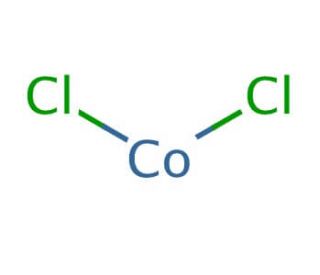
Click on image or enlarge button to enlarge
Cobalt(II) chloride: sc-252623
Cobalt(II) chloride (CAS 7646-79-9)
See product citations (7)
Application:
Cobalt(II) chloride is the most common cobalt compound found in laboratories used as a moisture indicator
CAS Number:
7646-79-9
Molecular Weight:
129.84
Molecular Formula:
CoCl2
Supplemental Information:
This is classified as a Dangerous Good for transport and may be subject to additional shipping charges.
For Research Use Only. Not Intended for Diagnostic or Therapeutic Use.
* Refer to Certificate of Analysis for lot specific data.
QUICK LINKS
Ordering Information
Product Citations
Description
Technical Information
Safety Information
SDS & Certificate of Analysis

Cobalt(II) chloride (CoCl2) is the most common cobalt compound found in laboratories. The dramatic color change of blue-purple Cobalt(II) chloride to a rose color when hydrated makes CoCl2 an excellent indicator for water in dessicants. As an inducer of HIF-1 production, Cobalt(II) chloride has been used to study apoptotic effects in HepG2 cells. Also reported as a stabilizer for reconstitution of the radiopharmaceutical technetium-99m exametazime. CoCl2 has been used in studies to examine heat shock protein expression of inflamed skin.
Also available: Cobalt(II) chloride hexahydrate (sc-203004).
Also available: Cobalt(II) chloride hexahydrate (sc-203004).
References:
- Expression of heat shock proteins in heavy metal-provoked inflamed human skin. | Nordlind, K. 2002. Immunopharmacol Immunotoxicol. 24: 383-94. PMID: 12375735
- CoCl2, a chemical inducer of hypoxia-inducible factor-1, and hypoxia reduce apoptotic cell death in hepatoma cell line HepG2. | Piret, JP., et al. 2002. Ann N Y Acad Sci. 973: 443-7. PMID: 12485908
- Chromosomal aberrations induced by cobaltous chloride in mice in vivo. | Palit, S., et al. 1991. Biol Trace Elem Res. 29: 139-45. PMID: 1713470
- Cobalt (II) chloride promoted formation of honeycomb patterned cellulose acetate films. | Naboka, O., et al. 2012. J Colloid Interface Sci. 367: 485-93. PMID: 22074692
- Bis[bis-(penta-methyl-cyclo-penta-dien-yl)cobalt(III)] tetra-chlorido-cobaltate(II) di-chloro-methane disolvate. | Merola, JS., et al. 2013. Acta Crystallogr Sect E Struct Rep Online. 69: m504. PMID: 24426998
- A redox-silent analogue of tocotrienol inhibits cobalt(II) chloride-induced VEGF expression via Yes signaling in mesothelioma cells. | Sato, A., et al. 2014. Biol Pharm Bull. 37: 865-70. PMID: 24790010
- Lutein Attenuates Both Apoptosis and Autophagy upon Cobalt (II) Chloride-Induced Hypoxia in Rat Műller Cells. | Fung, FK., et al. 2016. PLoS One. 11: e0167828. PMID: 27936094
- Cobalt(II) chloride adducts with acetonitrile, propan-2-ol and tetrahydrofuran: considerations on nuclearity, reactivity and synthetic applications. | Stinghen, D., et al. 2017. Acta Crystallogr C Struct Chem. 73: 104-114. PMID: 28157128
- Cobalt(II) Chloride Modifies the Phenotype of Macrophage Activation. | Kumanto, M., et al. 2017. Basic Clin Pharmacol Toxicol. 121: 98-105. PMID: 28244246
- Crystal structure of hexa-kis-(dimethyl sulfoxide- kappa O)cobalt(II) bis-[tri-chlorido-(quinoline- kappa N)cobaltate(II)]. | Brescia, TK., et al. 2018. Acta Crystallogr E Crystallogr Commun. 74: 309-312. PMID: 29765712
- Triterpenoid corosolic acid attenuates HIF-1 stabilization upon cobalt (II) chloride-induced hypoxia in A549 human lung epithelial cancer cells. | Bahadori, MB., et al. 2019. Fitoterapia. 134: 493-500. PMID: 30898728
- The Effects of Inactivation of Pedunculopontine Tegmental Nucleus by Cobalt (II) Chloride on Cardiovascular Responses in Hemorrhagic Hypotensive Rats. | Mohebbati, R., et al. 2019. Basic Clin Neurosci. 10: 235-244. PMID: 31462978
- Dimerization of mitophagy receptor BNIP3L/NIX is essential for recruitment of autophagic machinery. | Marinković, M., et al. 2021. Autophagy. 17: 1232-1243. PMID: 32286918
- Cobalt (II) Chloride Regulates the Invasion and Survival of Brucella abortus 544 in RAW 264.7 Cells and B6 Mice. | Huy, TXN., et al. 2022. Pathogens. 11: PMID: 35631117
- Evaluation of technetium-99m exametazime stabilised with cobalt chloride as a blood flow tracer in focal cerebral ischaemia. | Gartshore, G., et al. 1994. Eur J Nucl Med. 21: 913-23. PMID: 7995284